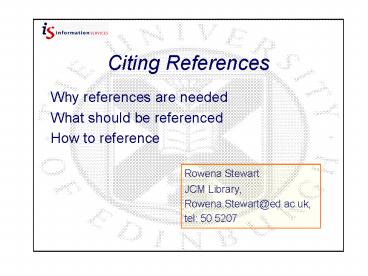Citing References - PowerPoint PPT Presentation
1 / 7
Title:
Citing References
Description:
To allow others to read what you have read & to follow up the information ... avoids hiatus in the text. good for references without a publication date ... – PowerPoint PPT presentation
Number of Views:59
Avg rating:3.0/5.0
Title: Citing References
1
- Citing References
- Why references are needed
- What should be referenced
- How to reference
- Rowena Stewart
- JCM Library,
- Rowena.Stewart_at_ed.ac.uk,
- tel 50 5207
2
Why do you need to provide references?
- To avoid plagiarism
- To allow others to read what you have read to
follow up the information sources you have found. - To indicate your research involved reading key
and pertinent work, to credit that work and show
where youve taken it further.
3
What you need to reference
Direct quotes Ideas, methodology, programs used,
etc which are not your own Work which has
influenced what you are writing up
What you do not need to reference
Established facts Generally accepted knowledge
Glossary
- Citation short reference in the text to
relevant work - Reference List full bibliographic details of
the references cited in the text. - Further Reading full bibliographic details of
works which have influenced you but are not cited
in the text. - Bibliography full bibliographic details of
works cited in the text plus those not cited but
which have influenced your work.
4
Format of citations and references
- The principles are to be consistent and provide
enough information for someone else to find what
you have read
- However, there are conventions and styles
- Author-Date
- ? provides some information about a reference in
the text. - Numbered, Numerical or Alphabet-Number
- ? avoids hiatus in the text
- ? good for references without a publication date
- Citation Order (not usually used in
scientific/technical publications)
If you are preparing a paper for publishing a
journal will have a house style and you should
use it. LATEX style guides may also be available
for download.
5
Where to place your citations
- Directly after the quote or idea, etc to which
you have referred - If a direct quote, the appropriate page number is
included in the citation or reference, depending
on the referencing style
How to format your citations
- Depends on the referencing style you use
- Author-date describes the citation style eg
(Smith, 2002) - Numerical is by number, a citation to the same
reference using the same number throughout the
text - Citation order is again by number but citations
are numbered sequentially through the text no
number is repeated
Footnotes are not usual in scientific
communication
6
Reference Lists
- Go at the end of the work, before Appendices
Reference List Organisation
- References are listed
- Author-Date style - alphabetically by author
- Numerical and Citation Order styles by citation
number
Bibliographic information required
See handouts for further details but, eg Harvard
style HEIN, J., REID, F., SMITH, L., BUSH, I.,
GUEST, M. SHERWOOD, P. (2005) On the
performance of molecular dynamics applications on
current high-end systems. Philosophical
Transactions of the Royal Society London, Series
A (Mathematical, Physical and Engineering
Sciences), 363, 1987-1998. SILYN-ROBERTS, H.
(2000) Writing for science and engineering
papers, presentations and reports, Oxford,
Butterworth-Heinemann.
7
Remember
When you think you have finished, check ? All
citations in your text are included in your
reference list. ? All the references in your
reference list are cited in your text.
Help
See the further information sources referenced in
your handouts
Rowena Stewartrowena.stewart_at_ed.ac.uk JCM Library
IS run a half day EndNote course
http//www.ucs.ed.ac.uk/usd/cts/courses/































